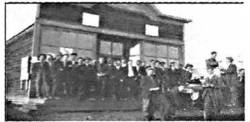Pipestone Flyer
The opening of Hoffman’s Store 1915
A young family from Minnesota, by the name of Rosso, was the first to establish a homestead along the Conjuring Creek just southwest of present day Calmar in the spring of 1894. By that fall they had been joined by a number of homesteaders from Kansas.
Homesteading is never easy and often one needs to supplement their income while establishing their homestead. Mr. Rosso found that he needed additional income and began to work at the White Star coal mine near Edmonton. As summer of 1894 was coming to an end tragedy struck when Mr. Rosso was killed in a mining accident. By the end of 1895 the family had left and the homestead was abandoned. Calmar’s first citizens were gone but in the spring of 1895 the settlers from Kansas had been joined with additional homesteaders from Kansas and Utah.
The closest community for these settlers was Leduc. Travel to Leduc wound through 18 miles (29K) of trails and creeks for a wagon and team. A two-day trip if the weather cooperated.
Swedish farmers in North Dakota were suffering from a serious drought so they sent Peter Ronn and Carl J. Blomquist to scout out possible homestead sites in western Canada. They arrived in 1895 and filed for land a little northwest of Calmar. Blomquist’s glowing accounts of the land soon resulted in a number of Swedish immigrants from North Dakota and Minnesota establishing homesteads along the Conjuring Creek. For a time the area was called the “Swedish Settlement”.
They arrived just in time to face one of the harshest winters encountered in several years. In the middle of the winter the Griffiths family were awoke to a major fire where they lost all of their possessions and were forced to move to Seattle. Their farm was taken over by Thomas Fetherston. The Alpaugh family took over the Rosso homestead and together with Fetherston established the first school for the district. The school was established in 1897 and was also used for church services and the occasional concert. The school was built on a creek bank covered with Alberta Roses and was named Rose Hill.
From 1897 to 1900 the area continued to grow and was generally referred to as the Conjuring Creek settlement. In 1898 John A. Sangster became the postmaster for Conjuring Creek and the local mailman for the surrounding post offices. In 1899 C.J. Blomquist became the postmaster for the Swedish Settlement and called the post office Calmar. Kalmar, Sweden had been Mr. Blomquist’s hometown. The post office was eventually moved to the present day site of Calmar.
Calmar’s beginnings can be traced back to when the local Farmers’ Co-operative built a small building to hold supplies and assist in the marketing of their produce. The co-operative failed and in 1915 Joe Hoffman bought the building and started a general store. Then a blacksmith set up shop, which was soon followed by a creamery. When the Calmar post office was moved from Blomquist’s farm to the Calmar site the community was on its way. Soon after the Rose Hill school was moved to the townsite.
A major drought in the US had driven many settlers north to Canada. Many could not believe what they saw as they approached their homesteads in the Calmar area. Water was everywhere and the rain would seem to never stop. This made the transportation of goods and services very difficult and the need for a major road.
Calmar’s existence seemed to be insured when Robert Telford’s road crew built the blind line right through the community. However, when the railroad decided to run it’s line about a half mile south of Calmar the community, unlike other communities faced with the same decision, refused to budge. The CPR even tried to rename the new station Calverly. Calmar merchants refused to accept the railroad’s decision and eventually the CPR relinquished to the area residents wishes and named the siding and station Calmar.
During the 1940’s the area saw major oil and gas development and rapid growth. In 1949 Calmar was granted village status and five quick years later was incorporated as a town. Calmar had a population of 800 people and it’s school boosted over 600 students.
Today Calmar is a town with a population of about 2000 and has shifted and adapted from an agriculture-based community to a more diverse population. Calmar has retained its rural values where raising a family remains a central focus for the town. Just as it was for the founders of the community education remains a major concern for Calmar residents.
Residents no longer worry about the dangers and pitfalls when taking a trip to Leduc and the two communities have continued to be good neighbors.
The Rosso Family never got to see how their homestead would become part of the history of central Alberta and the development of the Town of Calmar, but Calmar’s first postmaster Carl Blomquist did witness the day Calmar stood up to the CPR and solidified the town’s location. One of Calmar’s most noted citizen was C.H Stout, but that’s a story for another day.